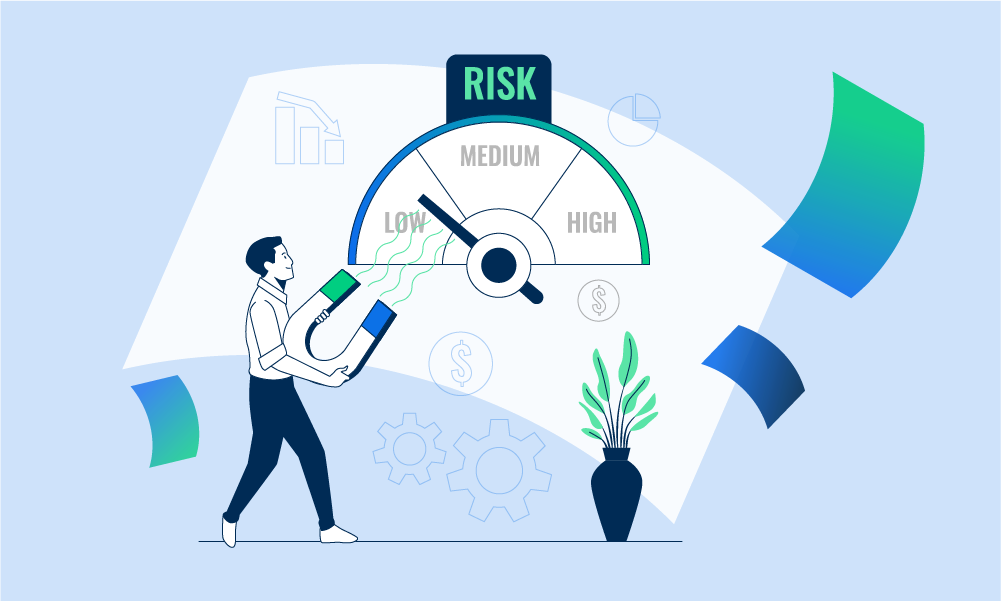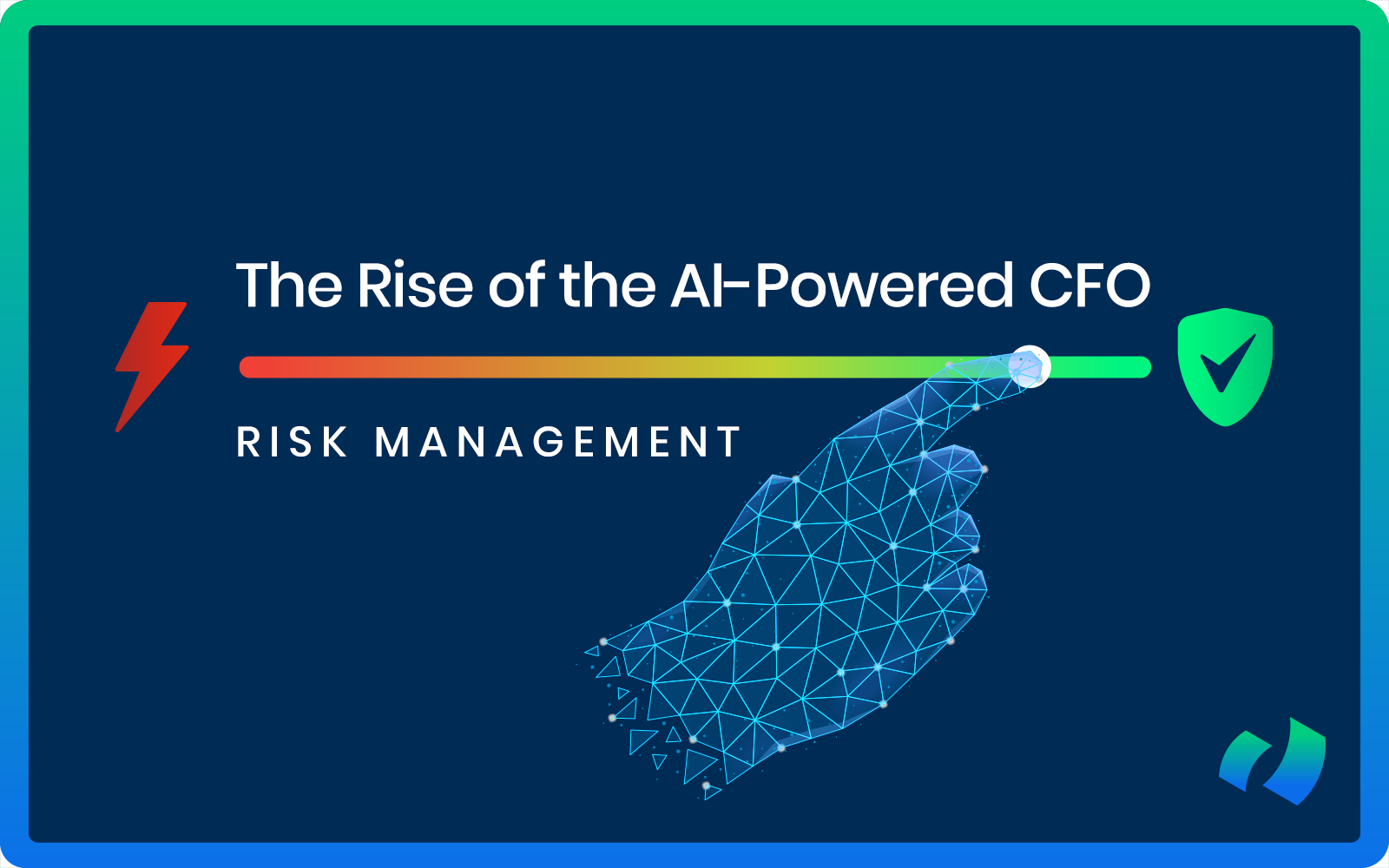This post is the fourth edition of our ‘The Rise of the AI-Powered CFO’ series.
CFOs are on the front lines of navigating a complex web of risks that can impact their organizations. From fluctuating market conditions and credit risks to regulatory changes and operational failures, the range of challenges is vast and varied.
Traditionally, managing these risks has relied heavily on manual processes, extensive spreadsheets, and the seasoned intuition of financial experts.
As the volume, velocity, and complexity of financial data grow, the shortcomings of traditional methods are becoming more evident. In response, many companies are turning to advanced technologies to enhance their risk management strategies.
Artificial intelligence is at the forefront of this technological shift, offering new tools and capabilities that promise to transform how CFOs detect, analyze, and mitigate risks. With its ability to process vast amounts of data at lightning speed, AI can analyze and monitor various factors such as market trends, customer behavior, and regulatory changes to identify potential risks before they escalate.
By integrating AI into their operations, finance leaders can not only streamline processes but also achieve more accurate and predictive insights. In this article, we will explore how AI is reshaping risk management for CFOs and the benefits it offers.

Challenges of Traditional Risk Management
The dynamic nature of financial markets makes risk management an ever-evolving challenge. The traditional approach, which relies heavily on human judgment and manual data analysis, is no longer sustainable.
Let’s explore some of the common risk management challenges that CFOs face today:
- Data Overload
The exponential growth of data in the digital age presents a significant challenge. Manually processing and analyzing massive volumes of data is not only inefficient but also increases the chance of overlooking crucial risk indicators. This overload can obscure key insights, making it difficult to identify and mitigate potential threats in a timely manner.
- Human Error
Human error remains a persistent risk in financial management, particularly when teams handle complex datasets or execute repetitive tasks. The consequences of such errors can be substantial, affecting everything from financial forecasts to compliance reports. Automating routine and complex tasks such as accounts payable can help minimize these risks, allowing human expertise to focus on more strategic decision-making processes.
- Limited Insights
Traditional risk management often relies on historical data, which may not adequately predict future conditions or risks. This approach typically provides limited insights, which can prevent CFOs from understanding the full spectrum of potential risks. By incorporating more dynamic and sophisticated predictive models, CFOs can enhance their ability to anticipate and react to future challenges.
- Fast Market Changes
Financial markets are inherently volatile, often influenced by unpredictable economic shifts, geopolitical events, and technological disruptions. Adapting to these rapid changes requires agile decision-making processes, which traditional manual methods cannot provide. Real-time data analysis and flexible risk management strategies are increasingly necessary to maintain a competitive advantage.
- Regulatory Compliance
Compliance with a complex array of ever-changing regulations is a daunting task for CFOs. Each jurisdiction may have its own regulatory framework, which can be a labyrinth of requirements that must be met diligently to avoid legal penalties. Effective risk management systems must adeptly adapt to regulatory changes without disrupting ongoing operations.
- Integration Challenges
Integrating advanced technologies like AI into existing financial systems is fraught with challenges. These include technical compatibility issues, substantial upfront costs associated with new technology acquisitions, and the ongoing need for training personnel to effectively utilize these tools. Overcoming these challenges is important for organizations that wish to leverage the full potential of AI.
- Dependence on Quality Data
AI-driven risk management heavily relies on the quality of the data it uses. Poor data quality -whether due to inaccuracies, incompleteness, or biases – can lead to flawed risk assessments. Ensuring high-quality data inputs is thus essential for generating reliable insights and maintaining effective risk management practices.
All these challenges underscore the need for CFOs to adopt sophisticated tools like AI, which can enhance their ability to manage risks proactively and adaptively. So, how does AI help CFOs manage risks?
The Role of AI in Risk Management
AI technologies, including machine learning, deep learning, and predictive analytics, provide powerful tools for automating complex decision-making processes. Why? These technologies can sift through massive datasets to uncover patterns and insights that are imperceptible to human analysts.
Machine learning algorithms, for example, are adept at identifying risk patterns from historical data, enabling predictive models that forecast potential financial pitfalls.
Deep learning enhances this further by analyzing more complex data structures and relationships, providing a more nuanced understanding of risk factors. Predictive analytics utilize these models to alert CFOs about potential risks, ranging from credit defaults to operational disruptions, well before they materialize.
The integration of AI not only speeds up the analysis process but also increases its accuracy, allowing CFOs to make more informed decisions swiftly. This proactive approach to risk management is essential in today’s volatile financial landscape, where the ability to react quickly can mean the difference between a minor setback and a major crisis.

How CFOs Can Use AI to Improve Risk Management
Integrating AI tools and techniques into risk management processes can bring significant benefits. Here are the top eight ways CFOs can use AI to enhance their risk management strategies:
- Data Processing and Analysis
- Predictive Capabilities
- Automation of Manual Tasks
- Real-time Monitoring
- Enhanced Fraud Detection
- Streamlined Compliance
- Automating Risk Assessment
- Risk Modeling and Mitigation Strategies
1) Data Processing and Analysis
AI’s ability to process vast amounts of data rapidly allows CFOs to identify critical risk indicators that might elude human analysis. This swift data processing aids in recognizing patterns and anomalies, enabling real-time, data-driven decision-making crucial in today’s fast-moving financial environments. The efficiency of AI in data analysis not only speeds up the risk identification process but also enhances the accuracy of assessments.
2) Predictive Capabilities
AI leverages a combination of historical data, current market trends, and various external factors to predict potential risks and assess their possible impacts on the organization. This forward-looking approach enables CFOs to proactively design and implement strategies that mitigate risks before they develop into significant threats, effectively reducing potential losses and enhancing operational resilience.
3) Automation of Manual Tasks
By automating routine and complex processes, AI-powered tools significantly reduce the burden on financial teams. This reduction in manual workload leads to a decrease in human errors and increases overall efficiency. Automation also allows finance teams to devote more time to strategic thinking and less to mundane tasks, thereby improving productivity and strategic use of human capital.
4) Real-time Monitoring
Continuous, AI-driven monitoring of various data sources ensures that CFOs have a holistic and up-to-date view of all potential risks. This capability is essential for dynamic and immediate responses to evolving risks, allowing financial leaders to implement changes or countermeasures instantly and effectively.
5) Enhanced Fraud Detection
AI’s sophisticated algorithms can sift through complex datasets to detect irregular patterns and potential fraudulent activities that traditional methods might overlook. This capability not only improves the detection rate of financial fraud but also significantly reduces the time taken to identify such risks, allowing for faster and more effective responses that protect the company’s assets and reputation.
6) Streamlined Compliance
AI systems can adapt swiftly to regulatory changes and ensure compliance by continuously monitoring and analyzing the regulatory environment. These systems can predict and alert CFOs to potential compliance risks, facilitating proactive adjustments to business practices. This foresight helps maintain compliance at all times, reducing the risk of legal penalties and enhancing the organization’s compliance posture.
7) Automating Risk Assessment
AI tools streamline the risk assessment process by automatically analyzing data to identify risks and evaluating their potential impact. This automation supports more frequent and thorough risk assessments, ensures consistency in how risks are evaluated, and helps develop prioritized, data-driven mitigation strategies.
8) Risk Modeling and Mitigation Strategies
Advanced AI risk modeling offers more precise predictions about future risks based on detailed analyses of existing data. These models enable CFOs to make well-informed strategic decisions crucial for long-term planning and risk management. Additionally, AI supports the development of robust risk mitigation strategies by simulating different scenarios and outcomes, helping CFOs prepare comprehensive responses to potential challenges.

The Future of Risk Management with AI
As we move forward, AI is set to revolutionize risk management by enhancing predictive analytics, automating decision-making, and integrating with other cutting-edge technologies. These advancements will enable organizations to anticipate and mitigate risks with unprecedented precision and efficiency.
AI’s capability to process and analyze vast datasets in real time will transform reactive risk management approaches into proactive strategies. This shift not only reduces potential losses but also promotes a more dynamic response to emerging threats.
Moreover, the future will see AI becoming more accessible to a wider range of organizations, democratizing advanced risk management tools and leveling the playing field across industries. However, this technological shift will also necessitate the development of robust ethical and regulatory frameworks to ensure AI’s responsible use, particularly in terms of transparency and fairness.
As organizations increasingly rely on AI, the role of the CFO and risk managers will evolve to encompass not only financial oversight but also strategic leadership in technology adoption and cybersecurity. Ultimately, AI is poised to significantly bolster organizational resilience and redefine risk management practices.




